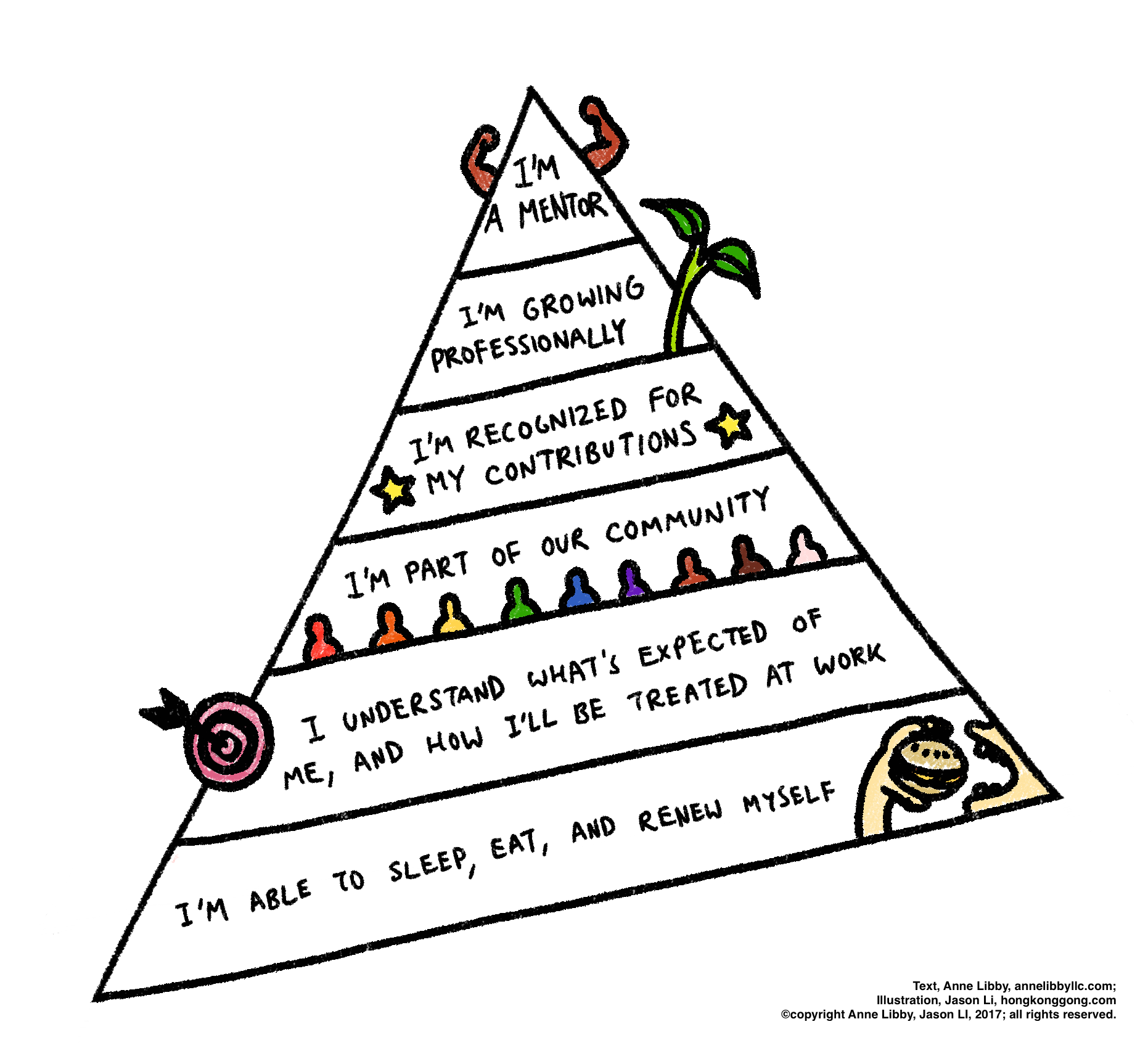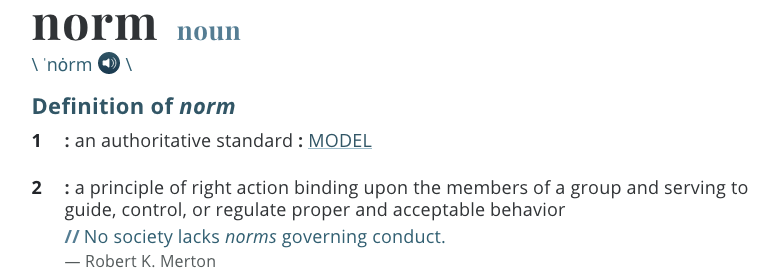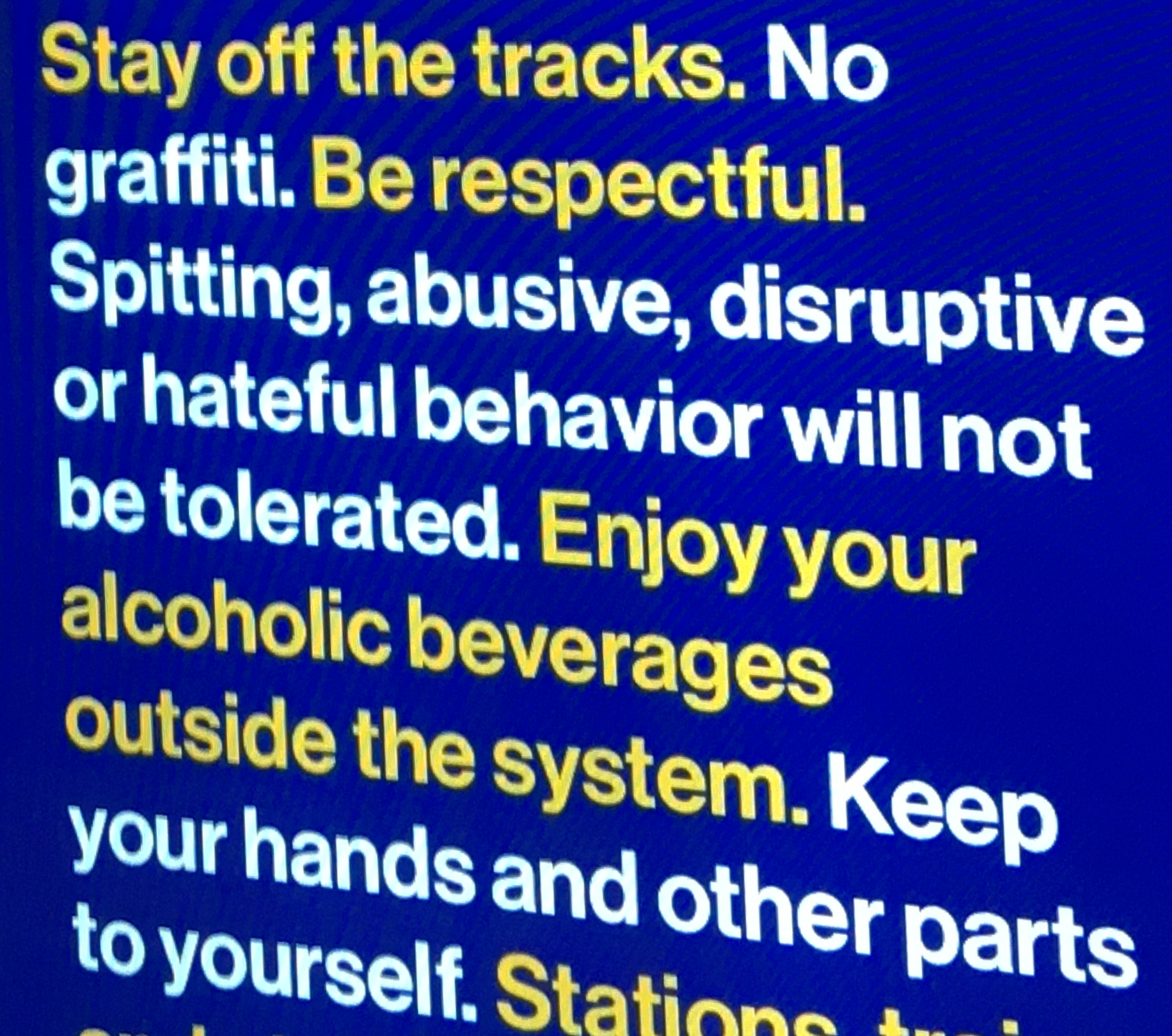Are norms really normal? On Management #39

Welcome to your extra hour of sleep. Or reading!
We talk about innovating, disrupting and culture. Yet, it’s apparently, um, normal for workplaces to be dominated by white guys named John. Or Jim. wth.
On this month’s audio, CV Harquail, author of Feminism: A Key Idea for Business and Society, talks with me about norms that limit our vision about what work can be.
Also, good things to read, watch, and listen to.
Thank you for inviting me to your inbox.
Healthy norms
If you’ve been reading for a while, you might remember Jason Li’s drawing of my hierarchy of needs at work.
Don’t your team members deserve to be able to make these statements?
(Spoiler alert: everyone does.)

Leaders can set habits and actions — norms — to make these statements into truths.
A limited set of examples:
- There’s a bounded workday, people take their PTO; we are not always on.
- Team members and managers work together to articulate reasonable individual and team goals.
- Because unspoken rules exclude, we aim to clearly state what it means to belong.
- We share credit.
- We help people grow — even when growth means that people may move on.
- We give leaders time to grow and develop junior staff members.
What habits, processes, actions can you set into motion that meet the needs of your team members, and contribute to flourishing?
Let’s go to the dictionary

Feminism has a branding problem
CV Harquail and I talk about the workplace: popular culture, media, and reality. And our aspirations for a better future: how can we create teams and workplaces where people flourish?
CV’s new book Feminism: A Key Idea for Business and Society (Indiebound) (library), is meant to inspire good questions and conversation about persistent workplace norms, and to expand our vision of what’s possible.

Relevant to our conversation:
- Amplification: Obama’s Female Staffers Came Up With a Genius Strategy to Make Sure Their Voices Were Heard by Claire Landsbaum at The Cut.
- Squad up: “Get out,” On Management #38 addressed actions taken by groups of senior women to address bias and harassment at Nike and Wells Fargo.
- When we discussed what we ask of people during parental leave, I actually said, “Aaaargh!” One representation of these norms: How to Prepare for Maternity Leave, by Julie Mosow at Harvard Business Review. Aaaargh.
- Episode 2: The Economy That Slavery Built (transcript), by Nikole Hannah-Jones and her New York Times team that made 1619.
- Two other interviews with CV: Episode 130 of Whitney Johnson’s Disrupt Yourself and Episode 72 of en(gendered) with Teri Yuan.
CV Harquail has taught leadership and organizational change at the Darden Graduate School of Business, University of Virginia, and entrepreneurship and lean startup methods at Stevens Institute of Technology. She received her PhD in Leadership and Organizations from the Ross School of Business, University of Michigan. You can find her on Twitter @cvharquail.
- CV’s book, Feminism: A Key Idea for Business and Society (Indiebound) (library.)
- Sign up for CV's newsletter, and get her insights about how feminism is transforming business and work.
- Check out Feminists at Work, led by CV and Lex Schroeder.
If you’re Deaf, hard-of-hearing, or otherwise need a transcript, send me a note and I’ll be sure you get one.
Disclosures: our conversation was edited for clarity and length. CV is a friend, and supporting member of On Management.
A useful idea: articulate your norms
Now streaming on NYC subway kiosks, The MTA Rules of the Ride. When 5.4 million people cross your threshold every weekday, a code of conduct can’t hurt.
Most would work for any office. (Unless graffiti fits the aesthetic.)

To be clear, and maybe a little bit pedantic, “be respectful” is more value than norm.
A workplace example, one clean desk norm from Aesop. (Others are here.)

The beauty of boldly stated norms: expectations aren’t secret — they’re not code that’s obvious only to the chosen. People have a better shot at knowing where they stand.
A truly inclusive workplace requires workplace norms that are safely accessible to all.
A question
What’s your approach to discussing organizational norms with colleagues and team members?
November 10: #livetweet9to5 with a fun group
One pathway in my conversation with CV Harquail led to the idea of what “flourishing” might look like at the office.
In my mind, an example: the transformed workplace at the end of the 1980 film 9 to 5, which included on-site childcare, accessible workstations, job sharing, and schedules and part-time work shaped around people’s family obligations…
Basically, imo, a workplace aligned with the feminist business practices CV describes.
40 years later, this workplace is vexingly elusive. In fact, “9 to 5” is no longer a norm for many of us when emails arrive around the clock. The gender wage gap is persistent.
If you’ve never seen the revenge fantasy-slash-comedy 9 to 5, it’s a treat.
On November 10, join me, and some of my favorite people on Twitter (and IRL) to watch — or re-watch — this eerily still relevant film:
Oh, and join me, @cvharquail, @yvahn, @amyvernon, and more, from your sofa, here on November 10 at 2:30 EST. We're live-tweeting the movie 9 to 5, inspired by my conversation with CV. #9to5movie #livetweet9to5 pic.twitter.com/fxUUcTWge8
— Anne Libby (@annelibby) October 26, 2019
“Take a beat and circle back”
This Samantha Jayne piece evokes both 9 to 5 and Anna Weiner’s upcoming Uncanny Valley. (I loved Uncanny Valley, and will review it later.)
h/t for the video: The Browser.
Silence as a workplace norm
The toxic power of silence as a norm is illuminated in two new books, both by journalists about their experiences reporting on #MeToo stories:
- Jodi Kantor and Megan Twohey’s She said: Breaking the Sexual Harassment Story that Helped Ignite a Movement (Indiebound) (library)
- Ronan Farrow’s Catch and Kill: Lies, Spies, and a Conspiracy to Protect Predators (Indiebound) (library)
Both describe how institutions — workplaces — and professional networks worked together to silence women’s allegations of workplace sexual harassment, assault, rape, and more.
Farrow’s personal story about his experience at work adds another layer of heartbreak to his tale. He worked, wanting to believe that his managers at NBC supported him.
Instead, he alleges, they were working against him to silence his reporting.
Three good pieces:
- Jodi Kantor and Megan Twohey on The Daily, “Keeping Harvey Weinstein’s Secrets,” Part 1: Lisa Bloom and Part 2: Gloria Allred.
- Terry Gross on Fresh Air, Ronan Farrow: 'Catch And Kill' Tactics Protected Both Weinstein And Trump.
- Rebecca Traister’s analysis at The Cut, Ronan Farrow Depicts a Chilling Cover-up at NBC.
NB: Farrow read his own audiobook, which I loved. (Twitter wasn’t sure about Ronan’s reading.)
Links
- The Very Radical Politics of Dolly Parton’s 9 to 5, the first episode of Sana Saeed’s Pop Americana. And, Jad Abumarad’s podcast Dolly Parton’s America.
- On calling something what it is. We need to talk about rape, by linguist Debbie Cameron.
- I appreciate Terry O’Reilly’s Under the Influence as a rare media view that incorporates and illuminates business history. This episode, erosion of a norm: Strange Bedfellows: Advertising & Porn, Part I.
And, a few things by my colleagues and/or On Management readers:
- Gary Chou is talking with Kirk Fernandes and Randy Brown, about their 1-year-old startup, Merit, on Season 1 of his new I Drink Two Beers and Try to Tell You How To Run Your Company Podcast.
- Sophie Brookover of Two Bossy Dames wrote recaps of Looking for Alaska at Vulture. Now, I must watch, so that I can read the recaps.
- Luke Schantz is one of the fine people behind the new(ish) IBM Developer podcast. Here, Luke talks with Diane Mueller, who organizes Red Hat OpenShift Commons.
Thanks
Thank you so much for reading!
Supporting members, thanks so much for contributing your moral support — and financial support — to my newsletter. Coming soon: an update, the audio transcript, and a reminder about November 14 Office Hours.
Thanks,
P.S. Join me for Performance Review Basics, a briefing
Team leaders, if you’re not comfortable leading performance reviews, you might feel like we’re moving into the least wonderful time of the year.
I’ve got some ideas that will help.
Next up: Performance Review Basics, in early 2020.

We’ll talk about what you can do now to prepare, and ways you can leverage your existing management routines to stay on track year round.
My last briefing was Manager as Coach. Briefings offer basic, essential information about a topic, basics on key skills, and space to ask your own questions, live.
Photo by Christina Morillo





